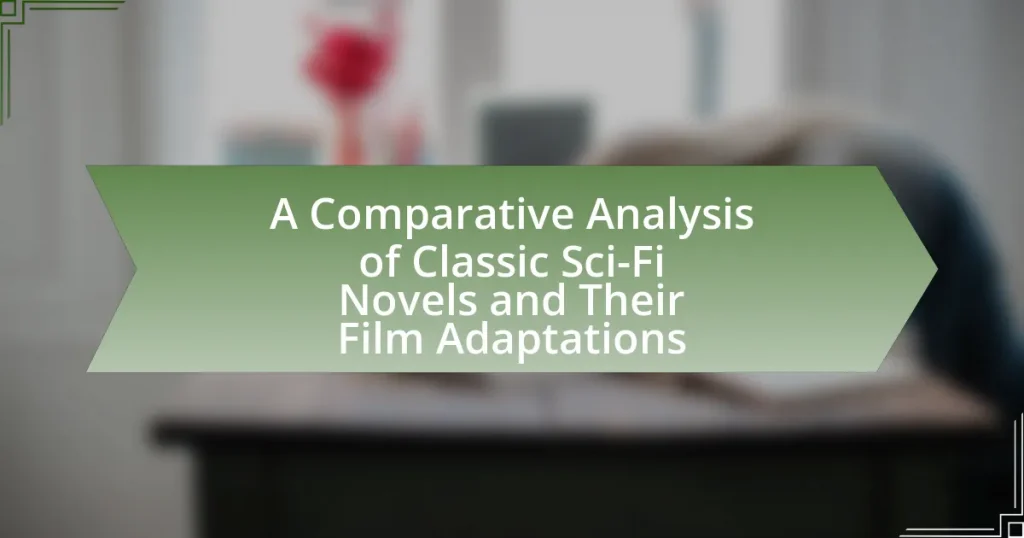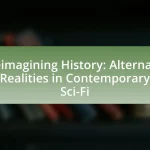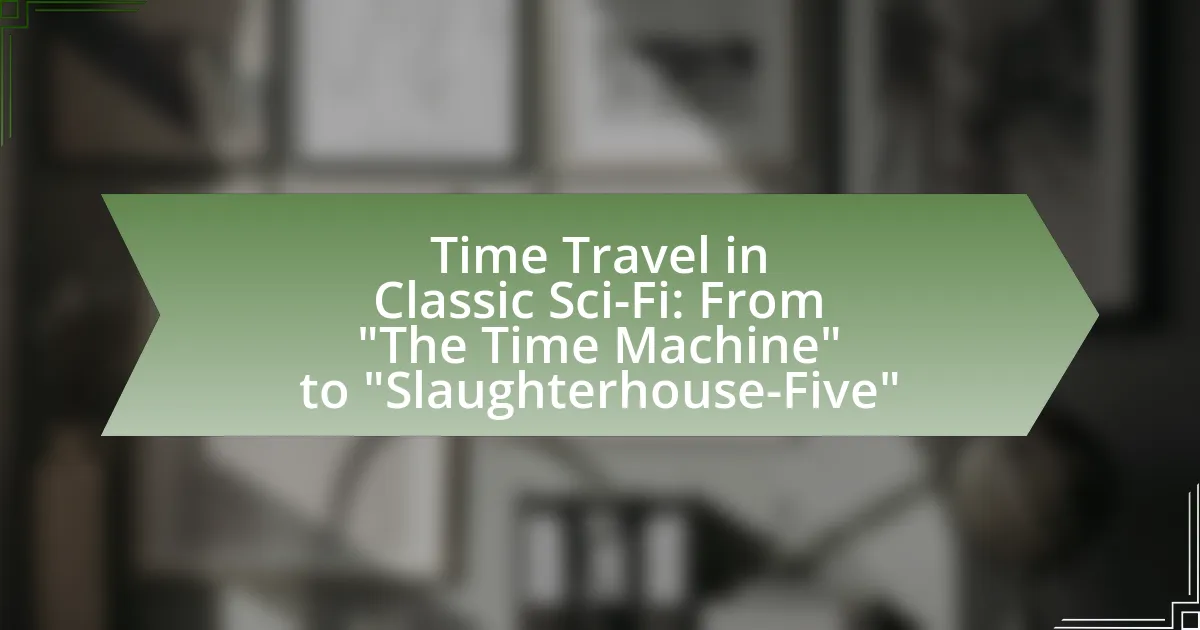The article provides a comparative analysis of classic sci-fi novels and their film adaptations, highlighting the significance of these works in exploring themes of technology, society, and human nature. It examines how novels like “1984” and “Fahrenheit 451” address contemporary issues such as surveillance and censorship, while their film adaptations enhance public discourse through visual storytelling. The article also discusses the influence of classic novels on their adaptations, the common themes explored, and the differences in narrative techniques between the two mediums. Additionally, it evaluates audience perceptions, critical responses, and the cultural context reflected in adaptations, offering insights into the relationship between literature and film.

What is the significance of classic sci-fi novels and their film adaptations?
Classic sci-fi novels and their film adaptations are significant because they explore complex themes of technology, society, and human nature, often reflecting contemporary anxieties and aspirations. For instance, novels like “1984” by George Orwell and “Fahrenheit 451” by Ray Bradbury address issues of surveillance and censorship, which resonate with modern concerns about privacy and freedom of expression. Their film adaptations, such as the 1984 movie “1984” and the 1966 film “Fahrenheit 451,” bring these themes to a broader audience, enhancing public discourse and awareness. Additionally, the visual storytelling in films can amplify the emotional impact of these narratives, making the underlying messages more accessible and engaging for viewers. This interplay between literature and film not only preserves the original works but also revitalizes them, ensuring their relevance across generations.
How do classic sci-fi novels influence their film adaptations?
Classic sci-fi novels significantly influence their film adaptations by providing foundational narratives, character development, and thematic depth. These novels often introduce complex worlds and ideas that filmmakers translate visually, shaping the film’s storyline and aesthetic. For example, Philip K. Dick’s “Do Androids Dream of Electric Sheep?” directly inspired the film “Blade Runner,” where the novel’s exploration of identity and humanity is central to the film’s plot and visual style. Additionally, the narrative structure and character arcs established in the novels serve as blueprints for screenwriters, ensuring that key elements resonate with audiences. This relationship between the source material and its adaptation is evident in how filmmakers interpret and visualize the original themes, often enhancing them through cinematic techniques.
What themes are commonly explored in classic sci-fi novels?
Classic sci-fi novels commonly explore themes such as the impact of technology on society, the nature of humanity, and the consequences of space exploration. These themes are evident in works like Isaac Asimov’s “I, Robot,” which examines the ethical implications of artificial intelligence, and Arthur C. Clarke’s “2001: A Space Odyssey,” which delves into human evolution and the unknowns of space. Additionally, themes of dystopia and utopia are prevalent, as seen in George Orwell’s “1984,” which critiques totalitarianism and surveillance. These thematic explorations reflect societal concerns and philosophical questions relevant to their time, making them enduring subjects in both literature and film adaptations.
How do these themes translate to film adaptations?
Themes from classic sci-fi novels often translate to film adaptations through visual storytelling, character development, and thematic emphasis. For instance, the theme of dystopia in George Orwell’s “1984” is depicted in film through stark visuals and oppressive atmospheres, enhancing the emotional impact. Similarly, the exploration of identity in Philip K. Dick’s “Do Androids Dream of Electric Sheep?” is conveyed in adaptations like “Blade Runner” through character interactions and visual motifs that highlight existential questions. These adaptations utilize cinematic techniques such as lighting, sound, and pacing to reinforce the original themes, making them accessible to a broader audience while maintaining the core messages of the novels.
Why is it important to analyze the relationship between novels and films?
Analyzing the relationship between novels and films is important because it reveals how narrative structures, themes, and character development are transformed across different mediums. This analysis allows for a deeper understanding of how adaptations can reinterpret source material, often reflecting cultural shifts or technological advancements. For instance, the adaptation of Philip K. Dick’s “Do Androids Dream of Electric Sheep?” into the film “Blade Runner” showcases significant changes in character portrayal and thematic emphasis, highlighting the impact of visual storytelling techniques. Such comparative studies enhance appreciation for both forms of art and provide insights into the creative processes involved in adaptation.
What insights can be gained from comparing narrative techniques in both mediums?
Comparing narrative techniques in classic sci-fi novels and their film adaptations reveals distinct storytelling methods that influence audience engagement and thematic interpretation. Novels often utilize internal monologues and detailed world-building, allowing for deeper character development and complex themes, as seen in works like “Dune” by Frank Herbert. In contrast, films rely on visual storytelling and pacing, which can condense or alter narrative elements for dramatic effect, exemplified by David Lynch’s adaptation of “Dune,” which faced criticism for its omission of key plot points. This comparison highlights how different mediums shape narrative delivery, affecting the audience’s understanding and emotional response to the story.
How do audience perceptions differ between reading and viewing?
Audience perceptions differ significantly between reading and viewing, primarily due to the engagement level and sensory experience involved in each medium. Reading requires active imagination and interpretation, allowing readers to construct their own mental images and emotional responses, which can lead to a deeper personal connection with the material. In contrast, viewing presents a visual and auditory experience that can evoke immediate emotional reactions but may limit individual interpretation, as the filmmaker’s vision is directly presented. Research indicates that readers often report a greater sense of immersion and investment in the narrative when reading compared to viewing, as evidenced by studies showing that readers of novels tend to engage more deeply with character development and thematic elements than viewers of film adaptations.

What are some notable classic sci-fi novels and their film adaptations?
Notable classic sci-fi novels and their film adaptations include “Dune” by Frank Herbert, adapted into films in 1984 and 2021, and “Fahrenheit 451” by Ray Bradbury, which was adapted in 1966 and again in 2018. “The War of the Worlds” by H.G. Wells has seen multiple adaptations, including the 1953 film and the 2005 version directed by Steven Spielberg. “2001: A Space Odyssey,” based on Arthur C. Clarke’s work, was released in 1968 and is renowned for its groundbreaking visuals. “Blade Runner,” adapted from Philip K. Dick’s “Do Androids Dream of Electric Sheep?” in 1982, is another significant adaptation. Each of these adaptations has contributed to the legacy of the original novels, often expanding their themes and visual storytelling.
Which classic sci-fi novels have received significant film adaptations?
Classic sci-fi novels that have received significant film adaptations include “Dune” by Frank Herbert, “The War of the Worlds” by H.G. Wells, “Fahrenheit 451” by Ray Bradbury, and “2001: A Space Odyssey” by Arthur C. Clarke. “Dune” has been adapted multiple times, with the most recent adaptation released in 2021, showcasing its enduring popularity. “The War of the Worlds” has seen various adaptations, including the notable 1953 film and the 2005 version directed by Steven Spielberg. “Fahrenheit 451” was adapted into a film in 1966 and again in 2018, reflecting its relevance in discussions about censorship. “2001: A Space Odyssey,” released in 1968, is a landmark film that has influenced the sci-fi genre significantly. Each of these adaptations has contributed to the cultural impact of the original novels, demonstrating their lasting significance in both literature and cinema.
What are the key differences between the novel and its film version?
The key differences between the novel and its film version often include alterations in character development, plot structure, and thematic emphasis. For instance, in many adaptations, characters may be simplified or combined to fit the film’s runtime, leading to a loss of depth found in the novel. Additionally, the film may condense or omit significant plot points, resulting in a different narrative flow. Thematic elements may also shift; for example, a novel might explore complex philosophical questions that a film adaptation simplifies for broader audience appeal. These differences highlight the challenges of translating literary works into visual media while maintaining the original’s essence.
How do adaptations reflect the cultural context of their time?
Adaptations reflect the cultural context of their time by incorporating contemporary societal values, technological advancements, and prevailing ideologies into their narratives. For instance, the film adaptation of “Blade Runner” (1982) mirrors the anxieties of the 1980s regarding corporate power and environmental degradation, which were significant concerns during that era. Similarly, adaptations of classic sci-fi novels often reinterpret themes to resonate with modern audiences, such as the exploration of artificial intelligence in “Ex Machina” (2014), which reflects current debates about ethics in technology. These adaptations serve as cultural artifacts that reveal how societal issues influence storytelling and character development, demonstrating the dynamic relationship between literature and the cultural zeitgeist.
What are the critical responses to these adaptations?
Critical responses to adaptations of classic sci-fi novels often highlight the tension between fidelity to the source material and the creative liberties taken by filmmakers. Critics frequently argue that adaptations can fail to capture the thematic depth and complexity of the original texts, as seen in the backlash against the film version of “Dune,” where some reviewers noted that the film oversimplified key philosophical concepts present in Frank Herbert’s novel. Additionally, adaptations like “Blade Runner” have received praise for their visual storytelling but criticism for diverging from the narrative intricacies of Philip K. Dick’s “Do Androids Dream of Electric Sheep?” This duality in responses underscores the ongoing debate about the merits and shortcomings of translating literary works into cinematic experiences.
How do critics evaluate the fidelity of adaptations to the source material?
Critics evaluate the fidelity of adaptations to the source material by analyzing how closely the adaptation adheres to the original narrative, themes, and character development. They assess specific elements such as plot structure, dialogue, and character arcs, comparing them to the source material to determine if the essence and intent of the original work are preserved. For instance, adaptations of classic sci-fi novels often face scrutiny regarding their portrayal of complex themes, such as technology’s impact on society, which are central to the original texts. Critics may reference specific scenes or character portrayals that either align with or diverge from the source, providing concrete examples to support their evaluations.
What role does nostalgia play in the reception of these films?
Nostalgia significantly influences the reception of films adapted from classic sci-fi novels by evoking fond memories of the original works and the cultural context in which they were first enjoyed. This emotional connection often leads audiences to approach these adaptations with heightened expectations, as they seek to relive the experiences associated with the source material. Research indicates that nostalgia can enhance viewer engagement and satisfaction, as seen in films like “Blade Runner 2049,” which references the original “Blade Runner” and appeals to fans of the 1982 classic. The positive reception of such films often stems from their ability to resonate with audiences’ nostalgic feelings, thereby reinforcing the cultural significance of the original novels and their themes.

How do specific elements of storytelling differ between novels and films?
Storytelling elements differ significantly between novels and films primarily in narrative depth and visual representation. Novels often provide extensive internal monologues and detailed descriptions, allowing for deeper character development and complex themes, as seen in works like “Dune” by Frank Herbert, where the inner thoughts of characters are crucial to understanding the plot. In contrast, films rely on visual storytelling and dialogue, necessitating a more concise narrative structure; for instance, the film adaptation of “Dune” focuses on visual spectacle and action to convey the story, often sacrificing the intricate internal conflicts present in the novel. This difference highlights how novels can explore nuanced psychological landscapes, while films emphasize visual and auditory elements to engage the audience.
What narrative techniques are unique to novels?
Novels uniquely employ narrative techniques such as stream of consciousness, unreliable narration, and extensive internal monologue. Stream of consciousness allows authors to depict characters’ thoughts in a flowing, unstructured manner, providing deep psychological insight, as seen in works like Virginia Woolf’s “Mrs. Dalloway.” Unreliable narration creates a distorted perspective, compelling readers to question the truth, exemplified in Nabokov’s “Lolita.” Extensive internal monologue enables detailed exploration of characters’ emotions and motivations, a technique effectively utilized in James Joyce’s “Ulysses.” These techniques enhance the depth and complexity of storytelling in novels, distinguishing them from other forms of narrative.
How does internal monologue affect character development in novels?
Internal monologue significantly enhances character development in novels by providing insight into a character’s thoughts, motivations, and emotional states. This narrative technique allows readers to understand the internal conflicts and complexities that shape a character’s actions and decisions. For instance, in classic sci-fi novels like “Dune” by Frank Herbert, the internal monologues of characters such as Paul Atreides reveal their struggles with destiny and power, deepening the reader’s connection to their journey. This depth of understanding is often lost in film adaptations, where visual storytelling may not convey the same level of introspection. Thus, internal monologue serves as a crucial tool for character exploration, making it essential for character development in literary works.
What role does world-building play in the narrative structure of novels?
World-building is essential in the narrative structure of novels as it establishes the setting, context, and rules of the fictional universe, which directly influences character development and plot progression. In classic sci-fi novels, such as “Dune” by Frank Herbert, the intricately crafted universe shapes the motivations and conflicts of characters, driving the narrative forward. The detailed world-building in such works provides a framework that allows readers to understand the stakes and dynamics at play, making the story more immersive and engaging. This is evidenced by the way Herbert’s depiction of the desert planet Arrakis not only serves as a backdrop but also as a catalyst for the political and ecological themes explored in the narrative.
What cinematic techniques enhance storytelling in film adaptations?
Cinematic techniques that enhance storytelling in film adaptations include visual storytelling, sound design, and editing. Visual storytelling utilizes imagery, color palettes, and composition to convey themes and emotions, as seen in films like “Blade Runner,” where the dystopian visuals reflect the novel’s themes. Sound design, including score and sound effects, adds emotional depth and atmosphere, exemplified by the haunting score in “Dune,” which amplifies the narrative’s tension. Editing techniques, such as cross-cutting and montage, can create dynamic pacing and juxtaposition of scenes, effectively conveying complex narratives, as demonstrated in “The Martian,” where rapid cuts enhance the urgency of survival. These techniques collectively contribute to a richer storytelling experience in film adaptations.
How do visual effects contribute to the storytelling of sci-fi films?
Visual effects significantly enhance the storytelling of sci-fi films by creating immersive worlds and visualizing complex concepts that are often beyond human experience. These effects allow filmmakers to depict futuristic technologies, alien landscapes, and extraordinary phenomena, which are essential for conveying the narrative’s themes and emotions. For instance, films like “Blade Runner” and “Interstellar” utilize visual effects to illustrate dystopian environments and cosmic journeys, respectively, thereby deepening the audience’s understanding of the story’s context and stakes. The integration of visual effects not only captivates viewers but also serves as a crucial narrative device that supports character development and plot progression, making the fantastical elements of the story more relatable and impactful.
What impact does sound design have on the viewer’s experience?
Sound design significantly enhances the viewer’s experience by creating an immersive atmosphere that complements visual storytelling. Effective sound design, including ambient sounds, sound effects, and music, engages the audience emotionally and helps convey the narrative’s mood and tone. For instance, in film adaptations of classic sci-fi novels, sound design can evoke feelings of tension or wonder, influencing how viewers perceive the story. Research indicates that sound can affect emotional responses; a study published in the Journal of Experimental Psychology found that music and sound effects can alter viewers’ interpretations of scenes, demonstrating the critical role sound design plays in shaping the overall viewing experience.
What practical insights can be drawn from analyzing classic sci-fi adaptations?
Analyzing classic sci-fi adaptations reveals insights into cultural values, technological predictions, and narrative structures. For instance, adaptations like “Blade Runner,” based on Philip K. Dick’s “Do Androids Dream of Electric Sheep?” highlight societal concerns about identity and humanity in the face of advancing technology. This reflects the 1980s’ anxieties regarding artificial intelligence and corporate power. Furthermore, adaptations often condense complex narratives, demonstrating how filmmakers prioritize visual storytelling over literary depth, as seen in “The Martian,” which simplifies Andy Weir’s detailed scientific explanations for broader audience engagement. Such analysis underscores the evolving relationship between literature and film, illustrating how adaptations can both reflect and shape public discourse on science and ethics.
How can writers improve their adaptations by understanding these differences?
Writers can improve their adaptations by understanding the differences in narrative structure, character development, and thematic expression between classic sci-fi novels and their film adaptations. Recognizing that novels often delve deeper into internal monologues and complex world-building allows writers to maintain the essence of the source material while adapting it for a visual medium, which typically prioritizes visual storytelling and pacing. For instance, in adapting “Dune,” understanding Frank Herbert’s intricate political and ecological themes enables writers to create a screenplay that captures the novel’s depth while translating it into compelling visual sequences. This approach not only preserves the original’s intent but also enhances audience engagement by aligning the adaptation with cinematic storytelling techniques.
What lessons can filmmakers learn from successful adaptations of classic sci-fi novels?
Filmmakers can learn the importance of maintaining the core themes and character arcs from successful adaptations of classic sci-fi novels. Successful adaptations, such as “Blade Runner” from Philip K. Dick’s “Do Androids Dream of Electric Sheep?”, demonstrate that preserving the philosophical questions and emotional depth of the source material enhances viewer engagement. Additionally, filmmakers should recognize the value of visual storytelling; for instance, “The Martian,” adapted from Andy Weir’s novel, effectively translates complex scientific concepts into accessible visuals, making the narrative compelling for a broader audience. These examples illustrate that fidelity to the original work’s essence, combined with innovative visual representation, can lead to critically acclaimed and commercially successful films.




